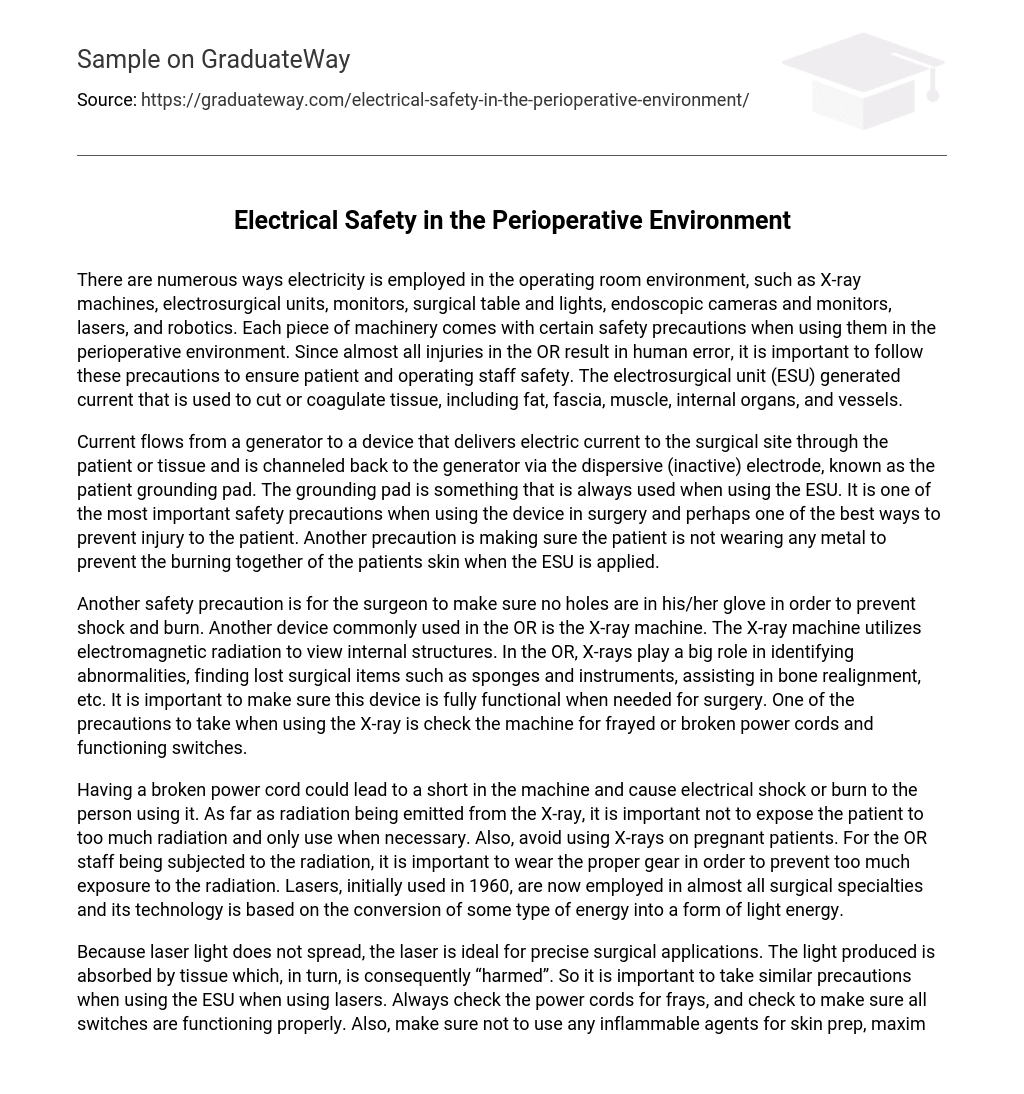There are numerous ways electricity is employed in the operating room environment, such as X-ray machines, electrosurgical units, monitors, surgical table and lights, endoscopic cameras and monitors, lasers, and robotics. Each piece of machinery comes with certain safety precautions when using them in the perioperative environment. Since almost all injuries in the OR result in human error, it is important to follow these precautions to ensure patient and operating staff safety. The electrosurgical unit (ESU) generated current that is used to cut or coagulate tissue, including fat, fascia, muscle, internal organs, and vessels.
Current flows from a generator to a device that delivers electric current to the surgical site through the patient or tissue and is channeled back to the generator via the dispersive (inactive) electrode, known as the patient grounding pad. The grounding pad is something that is always used when using the ESU. It is one of the most important safety precautions when using the device in surgery and perhaps one of the best ways to prevent injury to the patient. Another precaution is making sure the patient is not wearing any metal to prevent the burning together of the patients skin when the ESU is applied.
Another safety precaution is for the surgeon to make sure no holes are in his/her glove in order to prevent shock and burn. Another device commonly used in the OR is the X-ray machine. The X-ray machine utilizes electromagnetic radiation to view internal structures. In the OR, X-rays play a big role in identifying abnormalities, finding lost surgical items such as sponges and instruments, assisting in bone realignment, etc. It is important to make sure this device is fully functional when needed for surgery. One of the precautions to take when using the X-ray is check the machine for frayed or broken power cords and functioning switches.
Having a broken power cord could lead to a short in the machine and cause electrical shock or burn to the person using it. As far as radiation being emitted from the X-ray, it is important not to expose the patient to too much radiation and only use when necessary. Also, avoid using X-rays on pregnant patients. For the OR staff being subjected to the radiation, it is important to wear the proper gear in order to prevent too much exposure to the radiation. Lasers, initially used in 1960, are now employed in almost all surgical specialties and its technology is based on the conversion of some type of energy into a form of light energy.
Because laser light does not spread, the laser is ideal for precise surgical applications. The light produced is absorbed by tissue which, in turn, is consequently “harmed”. So it is important to take similar precautions when using the ESU when using lasers. Always check the power cords for frays, and check to make sure all switches are functioning properly. Also, make sure not to use any inflammable agents for skin prep, maximize distance from any monitoring equipment, and connect two separate circuits to avoid overload. With all of the machines in the OR, there are LOTS of cords as well.
Special precautions need to be made when dealing with cords. One factor is the humidity in the OR. Since water is a conductor of electricity, the humidity stays in the range of 50-55% in order to prevent water in the air from causing shortages leading to electrical shock, burns, or fire in the OR. Another precaution to take when dealing with cords, is to make sure the wires are wrapped with an insulator. Insulators are materials that inhibit the flow of electrons and are poor conductors of electricity. With these at play, there is less chance that injuries will occur.
Another rule of thumb is avoid using extension cords in the OR. These can cause those moving around to trip and pull the cord out of the wall and consequently damaging the cord of the machine. Also, avoid using liquids near any cords to prevent electrical shocks and fires. So as you see, there are many things that can go wrong in the Operating room, but there are just as many ways to prevent them from going on. It is important that everyone in the OR involved in surgery do their part in making sure the safety of the patient is maintained at all times to ensure the best possible outcome of the surgery.





